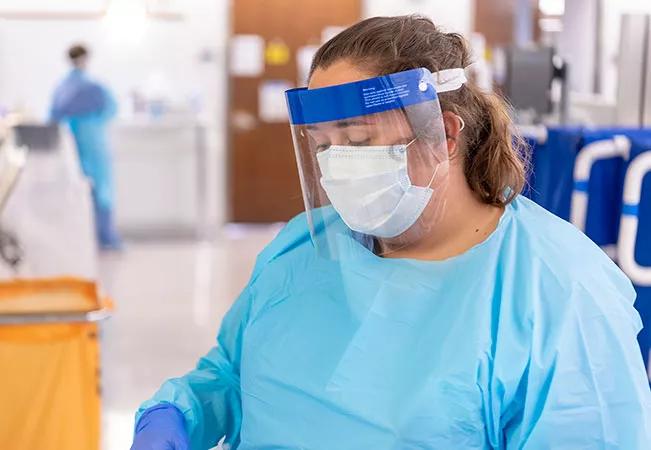Advertisement
Insights from a clinical psychologist for caregivers on the front lines and beyond

In recent weeks, Cleveland Clinic clinical psychologist Kathleen Ashton, PhD, ABPP, has been leading a weekly virtual meeting for the 30 or so caregivers she works with in the organization’s Breast Center. The 15- to 30-minute video conference is not about the patients the team treats for breast cancer and benign breast conditions. Instead, the focus is on the array of issues and emotions the caregivers are experiencing during the COVID-19 pandemic.
Advertisement
Cleveland Clinic is a non-profit academic medical center. Advertising on our site helps support our mission. We do not endorse non-Cleveland Clinic products or services. Policy
“The sessions are open to anyone on my team who wants to discuss what they are feeling that day, what they are doing well, what challenges they are facing and how they are taking care of themselves,” says Dr. Ashton. “It provides an opportunity to connect with others and know they are not alone.”
Healthcare providers working tirelessly to care for patients with COVID-19, as well as those whose practices have been upended by the pandemic, are faced with a variety of emotional and psychological effects. “No provider is able to care for people on the front lines if they are not well themselves,” says Dr. Ashton. “It’s important that they take time for self-care.”
All involved in healthcare delivery in this unprecedented time — from physicians and nurses to respiratory therapists and social workers — are subject to stresses that can impact their mental health and well-being. “Providers are experiencing fear and anxiety that they will contract the coronavirus or their families will be exposed through them,” says Dr. Ashton. “They’re also fearful that they will not be able to provide what their patients need and fulfill their mission as healers.”
At all healthcare organizations impacted by COVID-19, some providers are subject to feelings of helplessness. For instance, across the country many providers worry about not having enough personal protective equipment for themselves or ventilators for critically ill patients. Caregivers in various specialties may also feel powerless. “Surgeons are faced with putting off elective surgeries, which can leave them feeling bad about not being able to do all they typically can for their patients,” says Dr. Ashton.
Advertisement
Physical and emotional exhaustion is another risk. “Healthcare workers are in a crisis across much of the country, and some risk pushing themselves to work beyond their normal capacity,” Dr. Ashton notes. That can lead to feelings of isolation, which are exacerbated by social distancing.
While healthcare providers strive to help their patients, they often don’t heed their own advice about maintaining well-being. “There tends to be a stigma about reaching out for mental health help,” explains Dr. Ashton. “So it’s important for behavioral health providers to determine how best to reach out to caregivers and destigmatize that help by providing opportunities to receive it in ways caregivers are comfortable with.”
Short debriefings, like the weekly video conference Dr. Ashton offers her coworkers, are one option. A similar strategy is implementing online “doctors’ lounges,” where psychologists schedule a block of time for a virtual conference where physicians and other providers can pop in and out to connect with peers and where behavioral health providers are available to answer questions and suggest coping strategies.
Cleveland Clinic offers a 24-hour mental health hotline for its caregivers, as well as programming through its Caring for Caregivers staff and employee assistance program. During the COVID-19 pandemic, Cleveland Clinic CEO and President Tomislav Mihaljevic, MD, has been sending daily updates to all of the institution’s caregivers, some of which share resources for mental health assistance.
Advertisement
“For healthcare leadership, it’s really important to be in constant communication with employees, thanking workers for what they are doing, discussing provider safety, monitoring their staff’s mental health and providing mental health support,” observes Dr. Ashton. “Behavioral health providers can work with leaders — organizational management as well as department heads, nurse managers and others — to encourage those behaviors and lead effectively in a time of crisis.”
No matter the format that behavioral health providers opt to use, the message to stressed caregivers is the same. “Take frequent breaks for self-care, recognize and express your emotions — positive and negative — take time to connect with coworkers, and recognize what you are doing versus what you can’t control,” Dr. Ashton advises.
She recommends two sources offering advice for providers during the pandemic: the comprehensive resource page on COVID-19 from American Psychological Association (APA), and the National Center for PTSD’s article, “Managing Healthcare Workers’ Stress Associated with the COVID-19 Virus Outbreak.” Dr. Ashton is on the APA’s Board of Professional Affairs and is president-elect of the APA’s division for state, provincial and territorial affairs.
One of her overarching recommendations is for caregivers to adopt daily rituals to end their days. “Healthcare workers need 10 minutes or so to themselves to transition from work to home,” she says. “They might need time to breathe, reflect and meditate before they shift to being with their families, which requires a different mindset.” Part of that ritual may be physical: wiping down the car with disinfectant, removing and cleaning work clothes, or taking a shower.
“As stressful as all of this may be, we have amazing human resiliency,” Dr. Ashton concludes. “It’s just important to recognize that in order to be resilient, healthcare providers have to take care of ourselves now.”
Advertisement
Advertisement

Patients report improved sense of smell and taste

Clinicians who are accustomed to uncertainty can do well by patients

Unique skin changes can occur after infection or vaccine

Cleveland Clinic analysis suggests that obtaining care for the virus might reveal a previously undiagnosed condition

As the pandemic evolves, rheumatologists must continue to be mindful of most vulnerable patients

Early results suggest positive outcomes from COVID-19 PrEP treatment

Could the virus have caused the condition or triggered previously undiagnosed disease?

Five categories of cutaneous abnormalities are associated with COVID-19